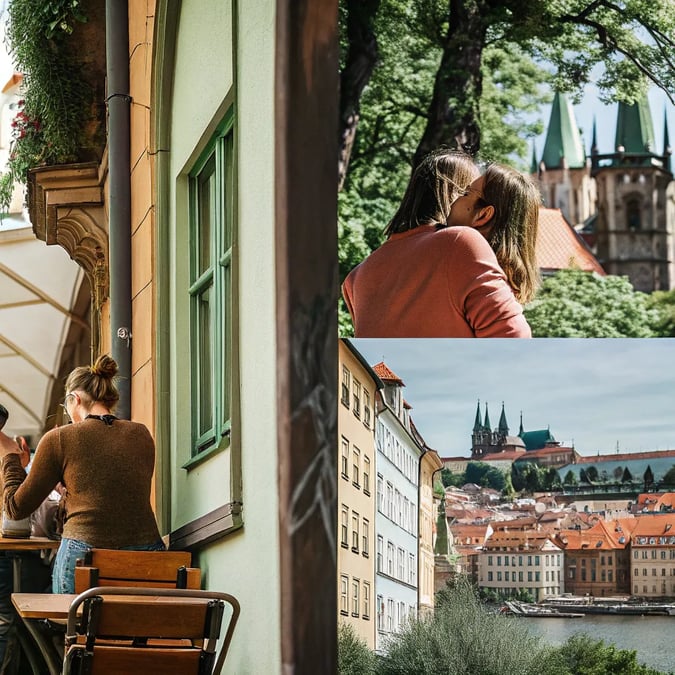
Eastern Europe remains one of the world's best-kept secrets for budget-conscious travelers who prefer to immerse themselves in local culture rather than rush between tourist hotspots. The region offers incredible value with monthly accommodation often available for under $2,000, while delivering rich history, stunning architecture, and authentic experiences that rival Western European destinations at a fraction of the cost.
What Makes Eastern Europe Perfect for Slow Travel?
Slow travel—the practice of spending extended time in fewer locations—has gained popularity as travelers seek deeper connections with destinations. Eastern Europe excels at accommodating this style of travel for several compelling reasons.
"I never expected to stay in Kraków for three weeks, but my budget stretched so far that I ended up renting a beautiful apartment near the main square for less than what a week would cost in Paris," shares Megan, a digital nomad I met during my own slow travel adventure last year.
The affordability factor can't be overstated. While Western European capitals might drain your savings at alarming rates, Eastern European cities offer comparable cultural richness at prices that allow for comfortable extended stays. You'll find excellent public transportation, abundant cafés with free WiFi, and welcoming locals who appreciate visitors who take time to explore beyond surface-level attractions.

Cost Comparison: Eastern vs. Western Europe
| Expense Category | Eastern Europe (Average) | Western Europe (Average) |
|---|---|---|
| Monthly Apartment Rental | $500-$900 | $1,200-$2,500 |
| Restaurant Meal | $7-$15 | $15-$35 |
| Local Transportation (Monthly Pass) | $20-$40 | $60-$120 |
| Coffee in Café | $1.50-$3 | $3.50-$6 |
| Museum/Attraction Entry | $5-$12 | $15-$30 |
Top Eastern European Cities for Extended Stays
1. Kraków, Poland
Kraków consistently ranks as one of the most affordable yet culturally rich cities in Europe. The well-preserved medieval core surrounds Rynek Główny, Europe's largest market square, where you can sip coffee for hours watching street performers and local life unfold.
What makes Kraków ideal for slow travel:
- Excellent English proficiency among locals
- Robust public transportation system
- Abundance of monthly rental options under $700
- Rich café culture perfect for digital nomads
- Proximity to natural attractions like Zakopane in the Tatra Mountains
"After two months in Kraków, I still hadn't exhausted the city's museums, and I'd barely scratched the surface of the local food scene," notes travel blogger Samantha Green, who documented her extended stay last year.
The city also serves as an excellent base for exploring southern Poland, with easy day trips to the Wieliczka Salt Mine and sobering visits to Auschwitz-Birkenau.
2. Budapest, Hungary
Split by the majestic Danube River, Budapest offers thermal baths, stunning architecture, and vibrant nightlife at prices that allow for comfortable long-term stays.
The city's affordability extends beyond accommodations—I spent three weeks there last autumn and found that transportation, food, and entertainment costs were roughly half what I'd paid in Vienna just before. My one-bedroom apartment in District VII (the trendy Jewish Quarter) cost €600 for the month, complete with a small balcony and modern amenities.
Budapest shines for slow travelers because:
- The extensive thermal bath culture encourages relaxation
- Excellent public transportation covered by inexpensive monthly passes
- Thriving specialty coffee scene with laptop-friendly cafés
- Regular cultural events and festivals throughout the year
- Easy train connections to other Central European destinations
District V offers proximity to major sights, while Districts VI and VII provide more local atmosphere with excellent restaurants and bars. For those seeking quieter surroundings, Buda's District II provides a more residential feel with excellent views.
3. Prague, Czech Republic
While slightly pricier than some Eastern European destinations, Prague remains affordable for slow travelers willing to venture beyond the tourist-heavy Old Town.
The city's fairytale architecture and winding cobblestone streets reward those who take time to explore systematically rather than rushing between Charles Bridge and the Astronomical Clock. Neighborhoods like Vinohrady and Žižkov offer authentic local experiences with excellent restaurants and cafés at reasonable prices.
Prague stands out for:
- Exceptional public transportation including trams, metro, and buses
- Vibrant cultural scene with affordable opera and classical music performances
- Beautiful parks and green spaces for daily walks
- Excellent day trip options to places like Český Krumlov and Karlštejn Castle
- Some of Europe's best and most affordable beer
"I rented a sunny apartment in Vinohrady for six weeks and established a wonderful routine—morning walks through Riegrovy Sady park, afternoons working in local cafés, and evenings exploring different neighborhoods. It felt like living in Prague rather than just visiting," shares remote worker Alex Thompson.
4. Lviv, Ukraine
Before Russia's full-scale invasion in 2022, Lviv was emerging as one of Eastern Europe's most charming slow travel destinations. While travel to Ukraine isn't currently advisable, Lviv deserves mention for future consideration when peace returns.
This UNESCO-listed city captivates with its well-preserved historic center, distinctive coffee culture, and remarkably low prices. Monthly apartment rentals before the war typically ranged from $300-500, making it one of Europe's best values.
Travel bloggers Frank and Lissette of BBQ Boy called Lviv "one of our favorite bases and one of the most underrated cities in Europe" after spending extended time there.
5. Brasov, Romania
For those seeking a smaller city experience with easy access to nature, Brasov in Romania's Transylvania region offers an ideal balance. Surrounded by the Carpathian Mountains, this medieval Saxon city provides a perfect base for slow travelers who appreciate outdoor activities alongside cultural exploration.
Brasov excels for extended stays because:
- Lower cost of living compared to Bucharest
- Walkable historic center with distinctive architecture
- Proximity to hiking trails and ski resorts
- Easy day trips to Dracula's Castle (Bran Castle) and medieval towns
- Growing digital nomad community with good WiFi infrastructure
"I initially planned to stay in Brasov for two weeks but extended to two months," says travel writer Emma Davis. "The combination of mountain views from my apartment window, the charming old town, and excursions to nearby villages gave me a much deeper appreciation for Romanian culture than I would have gained by rushing through."
Monthly rentals typically range from $400-700, with excellent restaurants offering full meals for under $10.
How Long Should You Stay in Each Location?
The beauty of slow travel lies in flexibility, but experienced slow travelers often suggest a minimum stay of 2-3 weeks to truly develop routines and connections in a destination. Many find that one month provides the ideal balance—enough time to move beyond tourist experiences without committing to a single location for too long.
"When I spent only one week in Sofia, Bulgaria, I felt like I barely scratched the surface. But after a month in Krakow, I had favorite cafés where baristas recognized me, a regular walking route, and even a few local acquaintances," notes long-term traveler James Wilson.
Consider these factors when determining your ideal stay length:
- Size and complexity of the city
- Seasonal factors (some places shine in specific seasons)
- Available accommodation discounts (many Airbnb hosts offer significant monthly discounts)
- Visa restrictions (non-EU citizens typically get 90 days in the Schengen Zone)
- Transportation connections to your next destination
Finding Affordable Monthly Accommodations
The cornerstone of successful slow travel is securing comfortable, affordable housing. Eastern Europe excels in this regard, with numerous options for extended stays.
Best Platforms for Monthly Rentals
While Airbnb remains popular, don't overlook these alternatives for better deals:
- Flatio - Specializes in mid-term rentals with lower fees
- Local Facebook groups (search "[City Name] Expats" or "[City Name] Apartments")
- Booking.com - Filter for monthly stays and negotiate directly with properties
- Local rental agencies (especially useful in smaller cities)
"I found my best apartment deals by joining local Facebook groups and asking for recommendations," shares digital nomad Sophia Martinez. "In Belgrade, I ended up renting directly from an owner for €450 monthly instead of the €700 listed on international platforms."
What to Look for in Slow Travel Accommodations
When selecting accommodations for extended stays, prioritize:
- Location near public transportation
- Fully equipped kitchen for home cooking
- Reliable internet (ask for speed test screenshots)
- Washing machine (laundromats are rare in some Eastern European cities)
- Heating/cooling appropriate for your travel season
- Workspace if you're working remotely
- Proximity to grocery stores and cafés
How Much Should You Budget?
Eastern Europe offers remarkable value, but costs vary significantly between cities. Based on recent traveler experiences and cost-of-living databases, here's what to expect for comfortable (not luxury) monthly budgets:
- Budget Tier ($1,000-1,500/month): Cities like Belgrade (Serbia), Sofia (Bulgaria), Bucharest (Romania)
- Mid-Range Tier ($1,500-2,000/month): Kraków, Budapest, Brasov, Riga (Latvia)
- Higher Tier ($2,000-2,500/month): Prague, Ljubljana (Slovenia), Tallinn (Estonia)
These budgets include accommodation, food (mix of cooking and eating out), local transportation, activities, and occasional day trips.
Getting Around: Transportation Between Cities
One advantage of slow travel in Eastern Europe is the reduced transportation cost when you're not constantly moving between destinations. When you do change locations, consider these options:
- FlixBus: Extensive network with extremely affordable fares when booked in advance
- Rail: Often more comfortable than buses for longer journeys, with scenic routes through the countryside
- Budget Airlines: Wizz Air and Ryanair offer incredibly cheap flights between Eastern European cities, often cheaper than ground transportation for longer distances
"I took an overnight train from Kraków to Budapest for about €30. It wasn't luxurious, but watching the sunrise over the Hungarian countryside made it an experience I'll never forget," recalls traveler Michael Chen.
Why Choose Slow Travel in Eastern Europe?
Beyond the obvious financial benefits, slow travel in Eastern Europe offers unique advantages:
- Authentic Cultural Immersion: With fewer international tourists than Western Europe, Eastern European cities offer more genuine local experiences.
- Developing Language Skills: Even picking up basic phrases is easier when you have time to practice regularly.
- Seasonal Appreciation: Extended stays allow you to experience local festivals and seasonal changes that brief visitors miss.
- Reduced Environmental Impact: Fewer transportation changes means a lower carbon footprint.
- Mental Well-being: The slower pace reduces travel fatigue and allows for more mindful experiences.
As one Reddit user in r/ExpatFIRE noted, "You can get really good 30-day stays in Eastern Europe for less than $2000," highlighting the region's exceptional value proposition for those looking to stretch their travel budget while gaining deeper experiences.
When is the Best Time for Slow Travel in Eastern Europe?
While Eastern Europe can be enjoyed year-round, certain seasons offer distinct advantages:
- Spring (April-June): Comfortable temperatures, blooming parks, and fewer tourists make this an ideal season for most cities.
- Summer (July-August): Warmest weather with abundant festivals and outdoor activities, but also peak tourist season in popular destinations like Prague.
- Fall (September-October): Beautiful autumn colors, harvest festivals, and pleasant temperatures before winter sets in.
- Winter (November-March): Significantly lower prices and magical Christmas markets, but be prepared for cold temperatures and shorter daylight hours.
"I spent January in Budapest and paid nearly half what summer visitors pay for the same apartment. Yes, it was cold, but the thermal baths were even more appealing, and the snow-covered Parliament building was breathtaking," shares winter traveler Rebecca Johnson.
Is Eastern Europe Right for Your Slow Travel Journey?
Eastern Europe isn't for everyone. You'll encounter less English proficiency in smaller cities, transportation infrastructure that sometimes lags behind Western Europe, and occasionally frustrating bureaucracy. However, these minor challenges are vastly outweighed by the benefits for most slow travelers.
The region is particularly well-suited for:
- Digital nomads and remote workers seeking affordability with good infrastructure
- History and architecture enthusiasts
- Culinary adventurers exploring less familiar food traditions
- Budget-conscious travelers wanting European experiences without Western European prices
- Those seeking authentic cultural exchanges away from overtourism
As one traveler aptly put it in a recent Reddit thread, "You have the same beautiful cities and culture in Western Europe but extremely cheap." This sentiment captures the essence of Eastern Europe's appeal for slow travelers—exceptional value without sacrificing experiences.
Whether you choose the medieval charm of Kraków, the thermal bath culture of Budapest, or the mountain scenery of Brasov, Eastern Europe rewards those who take time to settle in, establish routines, and experience destinations as temporary locals rather than hurried tourists.
Tags

About Elliot Navarro the Author
Elliot Navarro is a seasoned travel writer who has spent over a decade delving into the heart of diverse cultures across five continents. His expertise lies in embedding himself within local communities to truly experience the vibrant tapestry of languages, traditions, and lifestyles that define them.
Recommended Articles
10 Bucket List Destinations to Consider This Year
Explore ten captivating bucket list destinations including Maldives, Japan, Italy, and more. Perfect travel ideas for your next adventure this year!
The Most Scenic Train Tours for Seniors in 2025
Discover the best scenic train tours for seniors in 2025, offering comfort, stunning views, and unforgettable experiences across the globe.
10 Life-Changing Trips to Add to Your Bucket List Now
Explore these ten life-changing trips you must add to your bucket list now for unforgettable experiences and epic travel ideas.
5 Cities Seniors Are Traveling to This Year
Explore the top five cities seniors are traveling to this year. Discover cultural gems, scenic wonders, and senior-friendly experiences.
How to Tour Italy by Train Without Overspending
Explore Italy by train without overspending. This guide shares tips for budget travel, key routes, and money-saving strategies for an unforgettable journey.




